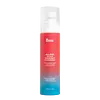What's inside
What's inside
 Key Ingredients
Key Ingredients

No key ingredients
 Benefits
Benefits

 Concerns
Concerns

No concerns
 Ingredients Side-by-side
Ingredients Side-by-side

Water
Skin ConditioningBisabolol
MaskingO-Cymen-5-Ol
Antimicrobial7-Dehydrocholesterol
Emulsion StabilisingMethyl Cyclodextrin
Allantoin
Skin ConditioningGlycerin
HumectantDisodium EDTA
Potassium Cocoyl Hydrolyzed Oat Protein
Skin ConditioningPotassium Chloride
Olea Europaea Leaf Extract
PerfumingGlyceryl Laurate
EmollientGlyceryl Caprylate
EmollientPhenoxyethanol
PreservativeChlorphenesin
AntimicrobialCitric Acid
BufferingCamellia Sinensis Leaf Extract
AntimicrobialPentylene Glycol
Skin ConditioningPolyglyceryl-10 Laurate
Skin ConditioningDipotassium Glycyrrhizate
HumectantCarbomer
Emulsion StabilisingSodium Phytate
Tromethamine
BufferingPlumeria Alba Flower Oil
Houttuynia Cordata Extract
Skin ConditioningCentella Asiatica Leaf Water
Skin ConditioningTremella Fuciformis Extract
HumectantHypochlorous Acid
AntiseborrhoeicWater
Skin ConditioningAloe Barbadensis Leaf Extract
EmollientPropanediol
Solvent1,2-Hexanediol
Skin ConditioningButylene Glycol
HumectantBetaine
HumectantEthylhexylglycerin
Skin ConditioningPhenoxyethanol
PreservativeAnthemis Nobilis Flower Water
MaskingAllantoin
Skin ConditioningCaffeine
Skin ConditioningTocopherol
AntioxidantGlycerin
HumectantCamellia Sinensis Leaf Extract, Pentylene Glycol, Polyglyceryl-10 Laurate, Dipotassium Glycyrrhizate, Carbomer, Sodium Phytate, Tromethamine, Plumeria Alba Flower Oil, Houttuynia Cordata Extract, Centella Asiatica Leaf Water, Tremella Fuciformis Extract, Hypochlorous Acid, Water, Aloe Barbadensis Leaf Extract, Propanediol, 1,2-Hexanediol, Butylene Glycol, Betaine, Ethylhexylglycerin, Phenoxyethanol, Anthemis Nobilis Flower Water, Allantoin, Caffeine, Tocopherol, Glycerin
Ingredients Explained
These ingredients are found in both products.
Ingredients higher up in an ingredient list are typically present in a larger amount.
Allantoin is a soothing ingredient known for its protective and moisturizingg properties. Because of this, it is often added to products with strong active ingredients.
Studies show higher concentrations of this ingredient can promote wound healing.
Though it can be derived from the comfrey plant, allantoin is produced synthetically for cosmetic products to ensure purity.
Learn more about AllantoinGlycerin is already naturally found in your skin. It helps moisturize and protect your skin.
A study from 2016 found glycerin to be more effective as a humectant than AHAs and hyaluronic acid.
As a humectant, it helps the skin stay hydrated by pulling moisture to your skin. The low molecular weight of glycerin allows it to pull moisture into the deeper layers of your skin.
Hydrated skin improves your skin barrier; Your skin barrier helps protect against irritants and bacteria.
Glycerin has also been found to have antimicrobial and antiviral properties. Due to these properties, glycerin is often used in wound and burn treatments.
In cosmetics, glycerin is usually derived from plants such as soybean or palm. However, it can also be sourced from animals, such as tallow or animal fat.
This ingredient is organic, colorless, odorless, and non-toxic.
Glycerin is the name for this ingredient in American English. British English uses Glycerol/Glycerine.
Learn more about GlycerinPhenoxyethanol is a preservative that has germicide, antimicrobial, and aromatic properties. Studies show that phenoxyethanol can prevent microbial growth. By itself, it has a scent that is similar to that of a rose.
It's often used in formulations along with Caprylyl Glycol to preserve the shelf life of products.
Water. It's the most common cosmetic ingredient of all. You'll usually see it at the top of ingredient lists, meaning that it makes up the largest part of the product.
So why is it so popular? Water most often acts as a solvent - this means that it helps dissolve other ingredients into the formulation.
You'll also recognize water as that liquid we all need to stay alive. If you see this, drink a glass of water. Stay hydrated!
Learn more about Water